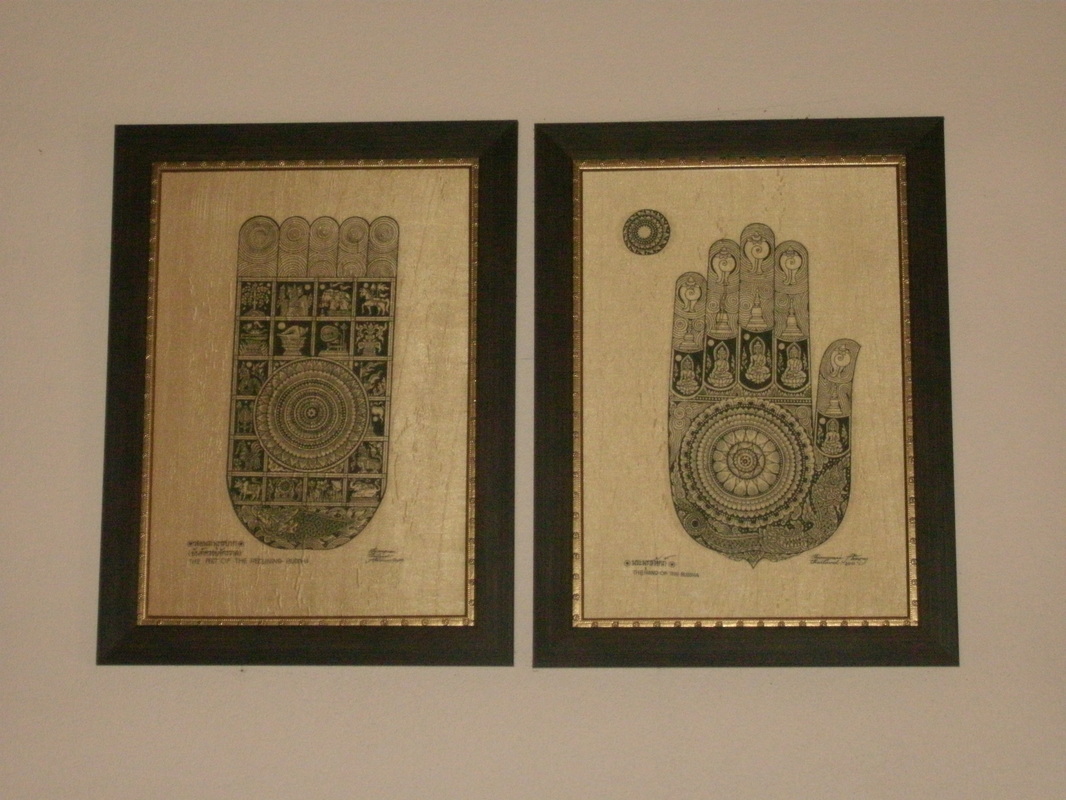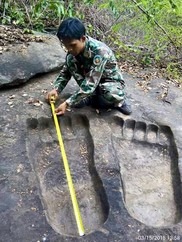|
The other day some folks in Thailand discovered a set of footprints of the Buddha. This reminded me of an artistic rendering of a footprint and handprint of the Buddha we received as a gift. My first encounter with Buddha’s footprints was during my first year here in Chiang Mai in about 1965 when the Rev. Pisanu Arkkapinya, who was teaching with me at the Thailand Theological Seminary, took a group of students to see historic temples in Lampang. One temple had a shrine dedicated to a highly venerated pair of footprints about two meters long. As I remember it, the footprints were said to commemorate a visit by the Lord Buddha to that place, which was a historic impossibility, except in some symbolic or metaphorical sense. I was impressed that the indentations in the footprints in Lampang had much in common with the markings on the soles of the feet of the 40 meter-long reclining Buddha in Wat Po, just behind the Grand Palace in Bangkok. More recently, in 2007 when I was residing in Bangkok, a shrine in front of the Asia Hotel was dedicated with solemn rites that, to all appearances, featured a modest piece of rock not much larger than a basketball said to contain a fragment of a footprint of the Buddha, verified by a very arcane process.
Regretfully, I neglected to collect a picture of the rock in front of the Asia Hotel, but together with the picture of the recently rediscovered footprints in the Northeast, and the artistic print on our living room wall, we can say they are three of the ways that the Buddha can be represented by his footprints. The first form is natural; an indentation on a rock or on a mountain top is understood to be an actual impression of where the Buddha stepped. A.B. Griswold reports that legends explain that after his enlightenment the Buddha made indelible impressions as he strode upon the land. The lore also gives a rationale for this. Donald Swearer puts it this way, “The Blessed One bestows various signs of his presence – hair relics and footprints being the most prominent – and grants permission for the construction of Buddha images.” The most sacred relics are those collected from the funeral pyre of the Buddha after his death. Then there are those which are pious creations inspired by earlier works of art and devotion, which were renditions of originals that were somehow donated by the Buddha directly. Cultural anthropologists specializing in Buddhist art have technical names for four levels of representations and have much to say about how they vary from age to age and region to region. The first category of “reminders” which the Buddha permitted out of compassion for his grieving disciples and their followers were dhatucetiya bodily relics, such as the tooth of the Buddha enshrined in the Temple of the Tooth in Kandy, Sri Lanka. The second category is paribhogacetiya consisting of reminders by association so that when the disciples saw those things they remembered how they were the Buddha’s; they included his alms bowls and robes, his footprints, the bench he sat on, the Bodhi tree in Bodhgaya under which he sat, and sites where events took place. During the early period of Buddhist representational art the Buddha himself was not pictured but was represented by such things as his bench, the tree, the wheel of the law in the form of a sun disc, or the protective Naga serpent, with a blank space where the Lord Buddha would have been. The third category is dhammacetiya, the whole body of teaching or Dharma, remembered in oral tradition for centuries and then written in canonical texts; this category also includes stupas which contain extracts of the Dharma, and (I am convinced) also buildings in temple compounds where the texts are stored and where they are expounded for the faithful to hear. The fourth category is uddesikacetiya “inductive” or derivative substitutes forparibhogacetiya which were actual items the Buddha used or were associated with him. This category became extremely important in the spread of Buddhism. A.B. Griswold mentions how Buddhist anticonography (also spelled aniconography) incorporated symbols that had formerly been religious symbols in their own right, such as the Naga of the cult of the King Serpent, the Bo tree from cults surrounding certain trees, the solar disc now transformed into a halo or nimbus behind the Buddha, and many others. Uddesikacetiya reminders were supposedly reproductions or artistic renderings of such things as the Buddha’s footprints. The category includes paintings or bas-relief renderings of the great events in the Buddha’s life. Indeed, in our villages in Northern Thailand were all the “reproductions and representative substitutes” removed there would be little left. But what do Buddha footprints mean and why are they significant? It has to do with more than the fact that they have an ancient origin, one that pre-dates the Buddha some 2500 years ago. In pre-Buddhist times (and in modern times to the present) to refer to oneself as beneath the foot of another is to indicate one’s place in a hierarchy. It is not about oppression, but about veneration. In a way it is the reverse of giving honor in the West where one expresses the great distance between royalty and common people by saying kings are highnesses and God is high and lifted up. In the Far East, at least in the area that inherited culture from India, Lord Hanuman worships Rama by placing his hand under Rama’s foot, and everyone including the Prime Minister of Thailand refers to himself or herself in addressing the King of Thailand as “dust under your foot” (tulee phrabat). In this culture, to express due veneration, one lowers oneself, both figuratively and on occasion physically and literally. The veneration being undertaken by the reverence being paid to Buddha footprints is with regard to the Buddha in three eras, past, present and future. There is a historic referent, while at the same time immediacy, and also anticipation. A footprint evokes the sense that at some time in the past, in some way, the Buddha was right here in this place. This place is evidence of the existence of the Buddha, and also of his regard for this place. There is a sense of urgency about a footprint, inasmuch as the one who made the impression has gone on and we are being left behind. A follower of the Buddha must walk the path that the Buddha walked in order to come to the end of the path that the Buddha achieved. There is also a sense of immediacy given that something of the Buddha remains. Clues to that residue are usually found in the indentations in the footprint. At the center of the print is almost always a round symbol, either of a wheel of the law or of a chakra (a center of energy, and in some expressions a sunburst) or a combination of both with the 8 or 16-spoke wheel superimposed on the blazing sun. Very commonly the Dharmachakra is accompanied by a checkerboard grid of auspicious symbols referring to aspects of the Buddha to be remembered. A spiritually sensitive person can expect to have renewed urgency to follow the Buddha as a result of attending to the messages being communicated by the footprint. Buddha footprints also evoke the promise that a Buddha, Phra Araya Maitrai (as it is pronounced here in the north), will be returning, as prophesied or promised (depending on the text) 2500 years from now. The sense is that even though the Buddha has gone, humankind is not abandoned. This sense of the future being taken care of is presented in many additional ways in Mahayana Buddhism. Buddha footprints come from the anticonic (“prior to the iconic”) stage of Buddhist art, the time before there were images of the Buddha. Instead, in those earliest centuries the Buddha was represented symbolically, by wheels referring to the “wheel of the law”, the Dharma. Or by a footprint. Or by a stupa (chedi [Thai], pagoda) standing both for the world mountain connecting heaven, earth and hell, as well as the reliquary in which relics of the Buddha or relics substituting for such relics are interred. A few stupas are supposed to actually have such venerable items, but most stupas just represent those more important ones. Here in North Thailand Buddha footprints have a further significance. Stories of mountains and legendary figures, ascetics, and supernatural beings of various kinds including gods and demons, were perennial favorites in the rich folklore of northern Thailand. These oral legends with pre-Thai origins were in time written on palm leaves and thick mulberry paper albums that became part of the popular preaching traditions of northern Thai Buddhism, and in this process of amalgamation and subsequent transformation they were Buddhasized. The Buddha emerges as the dominant figure in the narratives. Everyone else, whether ordinary villagers, ascetics, monks, kings, or supernatural beings, all play their part to facilitate the Buddha’s journey through the mountains and valleys of northern Thailand. The primary intent of these tamnan (chronicles/legendary histories) of the Buddha’s journey throughout Lan Na is to establish northern Thailand as a sacred land—literally a Buddha-land (Buddhadesa)—through a legacy of signs, primarily bodily relics and footprints. [Swearer, Donald K, Sommai Premchit, and Phaithoon Dokbuakaew, 2004. Sacred Mountains of Northern Thailand and their Legends. Chiang Mai: Silkworm Books. P. 24] Buddha’s footprints and relics, together with the tamnan narratives, validate the land, and by extension the rulers of the land.
0 Comments
Leave a Reply. |
AuthorRev. Dr. Kenneth Dobson posts his weekly reflections on this blog. Archives
March 2024
Categories |
| Ken Dobson's Queer Ruminations from Thailand |
|


 RSS Feed
RSS Feed
